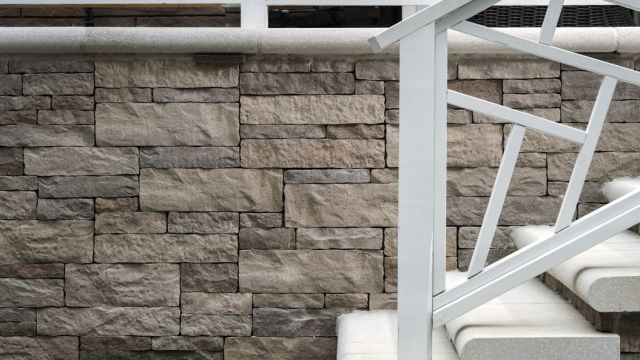Dry-cast manufacturing
The next step in the evolution of thin masonry veneer
By Oldcastle® Architectural, Inc.
For many years, architects and builders have appreciated the benefits of utilizing thin masonry veneers for a variety of projects. With the aesthetic appeal of full‐depth brick or natural stone, thin veneers typically cost significantly less to ship and install, can be used for both interior and exterior applications, and do not require the additional footings of natural stone or full‐depth masonry – all of which set thin veneer as the economical, versatile option for a multitude of architectural uses.
The manufacturing process developed to create these natural‐looking masonry products denoted the first step in the evolution of thin veneers. Now, the innovative new dry‐cast manufacturing process developed and patented by Oldcastle® Architectural Products has resulted in two new revolutionary products that represent the next step in this continued evolution.
Developing the “Natural” Stone Look
Industry‐wide, thin stone veneer is typically manufactured through a wet‐cast process, for which a mold is created by spraying latex over the surface of pre‐arranged natural stones. During the manufacturing process, the latex mold is placed in a metal pan and handpainted with colorant that will become the external colors of the manufactured stone units. Wet concrete is then poured into the mold, vibrated, and stored for 48‐72 hours to set and cure. Finished stones are then pulled from the molds and shipped for installation. After time and several uses, the latex molds may become fragile and degrade, sometimes tearing during the stone removal process. And because the colorant is only an external layer, the product may chip during shipping or installation, exposing the non‐colored concrete beneath. In addition, cutting the product reveals the aggregate on the interior of the unit, thus requiring the use of specialized corner pieces and trim for a finished look.Introducing Dry-Cast Manufacturing
By developing the revolutionary dry‐cast manufacturing process, Oldcastle both streamlined production and created a superior product. This dry‐cast method begins by scanning natural stone with a new innovative process and turning those scans into patented mold technology, which has a significantly longer life span than latex or rubber. A low moisture mixture of fine aggregates, cement, admixture and integrated colorant are densely compacted into the molds, then stripped from the molds and cured in a high‐humidity environment for 24 hours. The resulting stones offer a PSI strength that is two to three times stronger than traditional thin veneer and have color integrated throughout the unit, which eliminates the need for special corner pieces and reduces waste caused by chipping. Dry‐cast stones are freeze‐thaw resistant, water resistant, and fade resistant.Meet the Next Generation
Two new thin veneers were born from dry‐cast manufacturing in 2015: Hillcrest™ Stone and Kensley™ Stone thin veneers. The latest in Oldcastle Architectural’s line of Artisan Masonry Stone Veneers™, Hillcrest Stone offers a modular stack‐stone look with a tight dimensional tolerance, and Kensley Stone boasts a traditional ashlar pattern with a 3/8” mortar joint and is designed to emulate natural limestone. Both veneers weigh under 15 pounds per square foot and are available in six color blends. A third style, Westpeak™ Stone, is planned for release in early 2016. In the continued evolution of the veneer industry, Oldcastle is currently working with a network of distributors to gain product placement, as well as partnering with national and regional homebuilders.About the Author
Oldcastle® Architectural, Inc. is North America’s leading producer of concrete for the following markets: commercial masonry, professional landscaping and consumer DIY. For more information, visit www.oldcastleapg.com, or call 770-804-3363.
















